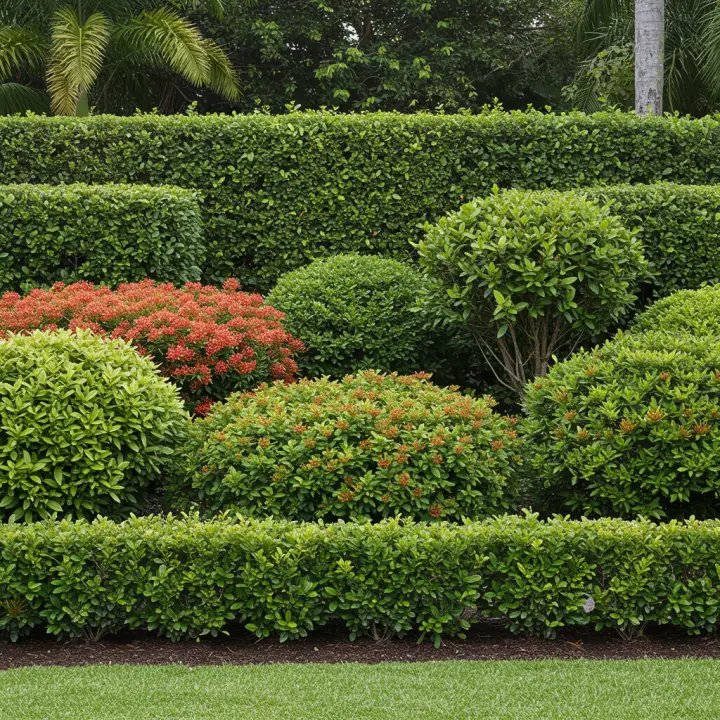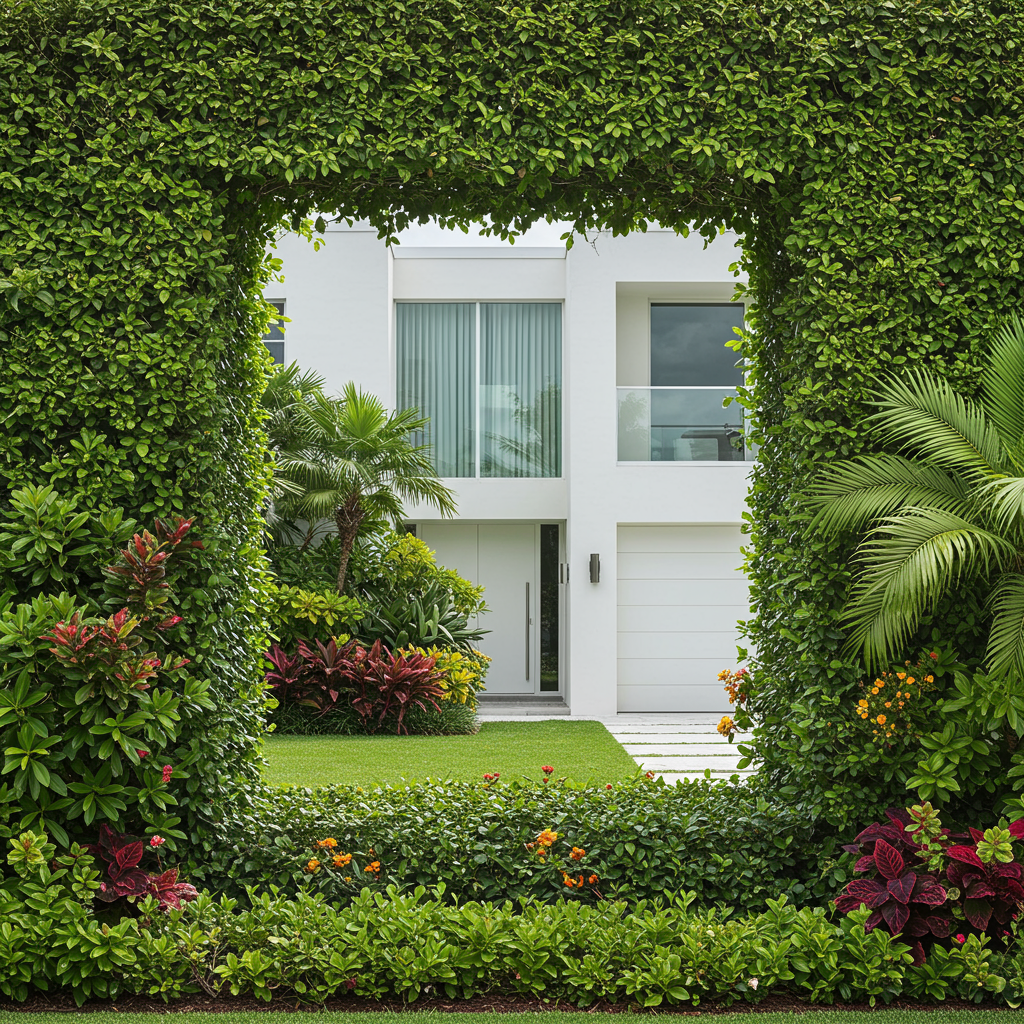Transform your landscape with the best hedge plants for South Florida homes, offering unmatched beauty, privacy, and resilience in the unique local climate. This guide will help you choose the ideal green screens to enhance your property, understanding their characteristics and care needs for a thriving, vibrant outdoor space.
South Florida’s vibrant landscape and year-round growing season make it an ideal place for lush, green hedges. More than just property dividers, well-chosen hedge plants can offer a myriad of benefits, from creating tranquil private sanctuaries to boosting your home’s curb appeal and even acting as a natural windbreak. However, the unique challenges of the South Florida climate—intense sun, humidity, occasional drought, and salty air near coastal areas—demand careful plant selection. This post will guide you through the top choices for stunning and resilient hedge plants, perfectly suited for your South Florida home.
Why Choose Hedge Plants for Your South Florida Home?
Hedges are a cornerstone of effective landscape design, offering both practical advantages and aesthetic enhancements, especially in the populous South Florida region.
Privacy and Security: Create natural barriers that shield your home from prying eyes and define your property lines, offering a sense of seclusion and safety.
Enhanced Curb Appeal: Lush, well-maintained hedges add significant beauty and structure, boosting your home’s visual appeal and potentially its value.
Noise and Wind Barriers: Dense foliage can help dampen urban noise and provide a natural windbreak, protecting more delicate plants and creating a more comfortable outdoor living space.
Ecological Benefits: Many hedge plants, particularly native species, offer habitats and food sources for local wildlife, contributing to a healthy ecosystem.
Structural Elements: Hedges can be shaped to create garden rooms, define pathways, or simply add architectural interest to your landscape.
Key Characteristics of Ideal South Florida Hedge Plants
Before diving into specific plant recommendations, it’s crucial to understand what makes a hedge plant suitable for the demanding South Florida environment.
Heat and Humidity Tolerance: Plants must withstand consistently high temperatures and humidity without succumbing to fungal diseases or stress.
Drought and Salt Tolerance: While South Florida experiences rainy seasons, dry spells occur. Plants that can tolerate periods of drought are advantageous. For coastal properties, salt tolerance (both from sea spray and soil) is non-negotiable.
Pest and Disease Resistance: Choosing naturally resistant varieties minimizes the need for chemical interventions, promoting a healthier garden.
Growth Rate and Mature Size: Consider how quickly you need your hedge to fill in and its ultimate size to ensure it fits your space and maintenance tolerance.
Low Maintenance Needs: Opting for plants that require less frequent pruning, watering, or special care can save you time and effort in the long run.
Top Picks for Stunning Hedge Plants in South Florida
Here are some of the best hedge plants that thrive and look fantastic in the South Florida landscape, offering a range of textures, colors, and growth habits.
Clusia (Clusia guttifera / Clusia rosea) – Pitch Apple
Known for its incredibly tough, leathery, dark green leaves, Clusia is a fantastic choice for a robust, low-maintenance hedge. It’s highly tolerant of salt, drought, and wind, making it ideal for coastal areas. Clusia grows densely and can be easily shaped, providing excellent privacy. It also produces attractive, light pink or white flowers and small, apple-like fruits.
Podocarpus (Podocarpus macrophyllus) – Japanese Yew
A classic and versatile hedge, Podocarpus offers a refined, upright appearance with dense, dark green foliage. It can be tightly sheared into formal hedges or allowed to grow more naturally. Podocarpus is remarkably hardy, tolerant of various soil conditions, and relatively pest-free. It’s an excellent choice for creating elegant, tall privacy screens.
Sweet Viburnum (Viburnum odoratissimum)
This fast-growing evergreen shrub is very popular for its lush, large, glossy green leaves. Sweet Viburnum forms a dense screen quickly and can reach significant heights, perfect for substantial privacy. It thrives in South Florida’s heat and humidity, offering a fresh, vibrant look year-round. While generally low maintenance, it does benefit from regular trimming to maintain its shape.
Green Buttonwood (Conocarpus erectus var. sericeus)
For a unique aesthetic and extreme resilience, the Silver Buttonwood (a cultivar of Green Buttonwood) is an outstanding native option. Its silvery-gray foliage provides a striking contrast and texture. This plant is incredibly salt-tolerant, drought-tolerant, and thrives in harsh conditions, including direct coastal exposure. It can be grown as a formal hedge or a multi-trunk tree, offering excellent screening capabilities.
Sea Grape (Coccoloba uvifera)
Another fantastic native plant, Sea Grape, is iconic to Florida’s coastlines. Its large, round, leathery leaves with reddish veins provide excellent screening and a distinct tropical look. Extremely salt-tolerant and drought-tolerant once established, it’s perfect for beachside properties. The plant also produces edible, grape-like fruit. While it can be left natural, it responds well to pruning for a denser hedge.
Areca Palm (Dypsis lutescens)
While not a traditional “bush” hedge, Areca Palms are widely used in South Florida for tropical privacy screens. Their clustering, feathery fronds create a soft, airy barrier that sways gracefully in the breeze. They thrive in partial shade but can tolerate full sun with adequate water. For a living wall with a distinct tropical flair, a row of Areca Palms is an elegant choice.
Surinam Cherry (Eugenia uniflora)
This dense, evergreen shrub offers beautiful, glossy green leaves that emerge with a reddish hue. It produces small, fragrant white flowers and edible, ribbed red-orange fruit. Surinam Cherry is an excellent choice for a hedge, as it self-prunes well and can be easily shaped. It’s tough, adaptable to various soils, and fairly drought-tolerant once established.
Essential Care Tips for Thriving South Florida Hedges
Even the toughest hedge plants for South Florida homes benefit from proper care to ensure they remain healthy, dense, and beautiful.
Proper Planting Techniques
Dig a hole twice as wide as the root ball and just as deep.
Ensure the plant is at the same level in the ground as it was in its container.
Backfill with native soil mixed with some compost to improve drainage and nutrients.
Water thoroughly immediately after planting.
Watering Schedule
Establishment Phase (first 3-6 months): Water frequently (daily or every other day), as consistent moisture is critical for root development.
Established Hedges: Reduce watering frequency. Most South Florida hedge plants are relatively drought-tolerant once established but will benefit from deep watering during dry spells. Check soil moisture before watering.
Fertilization
Fertilize 2-3 times a year (spring, summer, early fall) with a slow-release granular fertilizer formulated for trees and shrubs in Florida. Follow package directions.
Avoid over-fertilizing, which can lead to rapid, weak growth.
Pruning and Shaping
Timing: The best time to prune depends on the plant, but generally after a growth flush or after flowering. Avoid heavy pruning late in the year to prevent new growth from being damaged by potential cold snaps.
Technique: Prune regularly to maintain shape and density. Remove dead, damaged, or diseased branches. For a formal hedge, use sharp shears. For a more natural look, use hand pruners to selectively thin branches.
“A” Shape: For hedges that are wider at the bottom and narrower at the top, allowing sunlight to reach the lower branches and promoting even growth.
Pest and Disease Management
Regularly inspect your hedges for signs of pests (e.g., aphids, scale, mites) or diseases (e.g., fungus spots).
Address issues promptly with appropriate organic or chemical treatments, as needed. Healthy plants are more resistant to problems.
Choosing the Right Hedge for Your Needs
Selecting the perfect hedge involves considering several factors specific to your property and preferences:
Consider Purpose: Do you need maximum privacy, a windbreak, a decorative border, or an edible hedge?
Sunlight Exposure: Assess how much sun your chosen planting area receives throughout the day. Some plants prefer full sun, others partial shade.
Soil Type: While many Florida soils are sandy, understanding your specific soil conditions (drainage, pH) can help you choose the best fit.
* Desired Height and Spread: Envision the mature size of your hedge. How tall and wide do you want it to be? This will impact plant selection and spacing.
Frequently Asked Questions (FAQs) About South Florida Hedge Plants
Q1: How fast do South Florida hedge plants grow?
A1: Growth rates vary significantly by species. Fast-growing options like Sweet Viburnum and some Ficus species can grow 2-3 feet per year. Slower growers like Clusia or Podocarpus might add 6-12 inches annually.
Q2: What are the best privacy hedges for South Florida?
A2: For dense privacy, excellent choices include Clusia, Podocarpus, Sweet Viburnum, Green Buttonwood, and robust Areca Palms. These plants offer thick foliage and can reach considerable heights.
Q3: Do I need to fertilize my hedge plants?
A3: Yes, fertilizing 2-3 times a year with a balanced, slow-release fertilizer designed for trees and shrubs in Florida will promote healthy growth and vibrancy. Always follow product instructions.
Q4: Can I use native plants for my hedge?
A4: Absolutely! Native options like Green Buttonwood and Sea Grape are highly recommended. They are perfectly adapted to the South Florida climate, require less water and fertilizer once established, and support local wildlife.
Q5: How often should I prune my hedge?
A5: The frequency of pruning depends on the plant’s growth rate and your desired formality. Fast-growing hedges might need trimming every 1-2 months during the growing season, while slower growers might only need it 2-3 times a year.
Conclusion
Creating a stunning and functional hedge in South Florida is an achievable and rewarding endeavor. By understanding the unique demands of the local climate and selecting the right hedge plants for South Florida homes, you can establish a landscape that offers beauty, privacy, and resilience for years to come. Whether you opt for the robust Clusia, the elegant Podocarpus, or the native charm of a Silver Buttonwood, thoughtful planning and consistent care will ensure your hedge thrives, transforming your outdoor space into a personal oasis.


